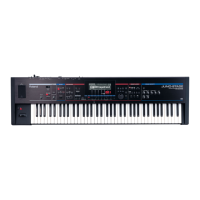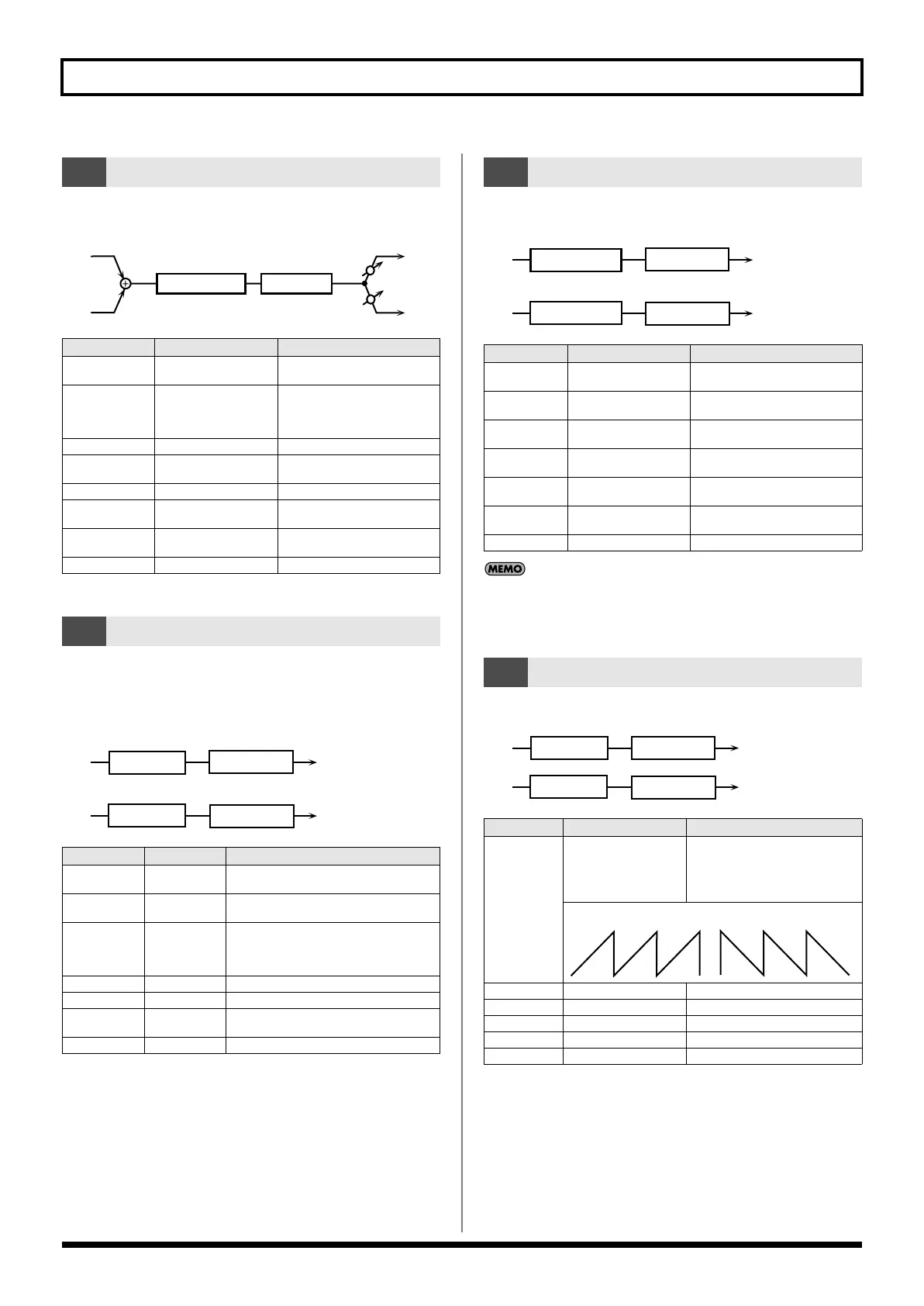169
Effects List
A phaser that continues raising/lowering the frequency at which the
sound is modulated.
fig.MFX-14
This is an effect that applies amplitude modulation (AM) to the input
signal, producing bell-like sounds. You can also change the
modulation frequency in response to changes in the volume of the
sound sent into the effect.
fig.MFX-15
This is a ring modulator that uses a 16-step sequence to vary the
frequency at which modulation is applied.
fig.MFX-16
You can use multi-effect control to make the step sequence play
again from the beginning (p. 164).
Cyclically modulates the volume to add tremolo effect to the sound.
fig.MFX-17a
14:
INFINITE PHASER
Parameter
Value Explanation
Mode
1, 2, 3, 4
Higher values will produce a
deeper phaser effect.
Speed #
-100–+100
Speed at which to raise or lower
the frequency at which the sound
is modulated
(+: upward / -: downward)
Resonance #
0–127
Amount of feedback
Mix #
0–127
Volume of the phase-shifted
sound
Pan #
L64–63R
Panning of the output sound
Low Gain
-15–+15 dB
Amount of boost/cut for the
low-frequency range
High Gain
-15–+15 dB
Amount of boost/cut for the
high-frequency range
Level
0–127 Output volume
15:
RING MODULATOR
Parameter
Value Explanation
Frequency #
0–127
Adjusts the frequency at which modulation is
applied.
Sens #
0–127
Adjusts the amount of frequency modulation
applied.
Polarity
UP, DOWN
Determines whether the frequency
modulation moves towards higher
frequencies (
UP
) or lower frequencies
(
DOWN
).
Low Gain
-15–+15 dB Gain of the low frequency range
High Gain
-15–+15 dB Gain of the high frequency range
Balance #
D100:0W–
D0:100W
Volume balance between the direct sound
(D) and the effect sound (W)
Level
0–127
Output level
Infinite Phaser 2-Band EQ
L in
R in
L out
R out
Pan R
Pan L
L in
R in
L out
R out
Ring Mod
2-Band EQ
2-Band EQ
Ring Mod
16:
STEP RING MODULATOR
Parameter
Value Explanation
Step 01–16
0–127
Frequency of ring modulation at
each step
Rate #
0.05–10.00 Hz, note
Rate at which the 16-step sequence
will cycle
Attack #
0–127
Speed at which the modulation
frequency changes between steps
Low Gain
-15–+15 dB
Amount of boost/cut for the
low-frequency range
High Gain
-15–+15 dB
Amount of boost/cut for the
high-frequency range
Balance #
D100:0W–D0:100W
Volume balance of the original
sound (D) and effect sound (W)
Level
0–127
Output volume
17:
TREMOLO
Parameter
Value Explanation
Mod Wave
TRI, SQR, SIN, SAW1,
SAW2
Modulation Wave
TRI:
triangle wave
SQR:
square wave
SIN:
sine wave
SAW1/2:
sawtooth wave
Rate #
0.05–10.00 Hz, note
Frequency of the change
Depth #
0–127
Depth to which the effect is applied
Low Gain
-15–+15 dB
Gain of the low range
High Gain
-15–+15 dB
Gain of the high range
Level
0–127
Output Level
L in
R in
L out
R out
Step Ring Mod
2-Band EQ
2-Band EQ
Step Ring Mod
L in
R in
L out
R out
Tremolo
2-Band EQ
2-Band EQ
Tremolo
JUNO-STAGE_e.book 169 ページ 2008年10月17日 金曜日 午後12時27分

